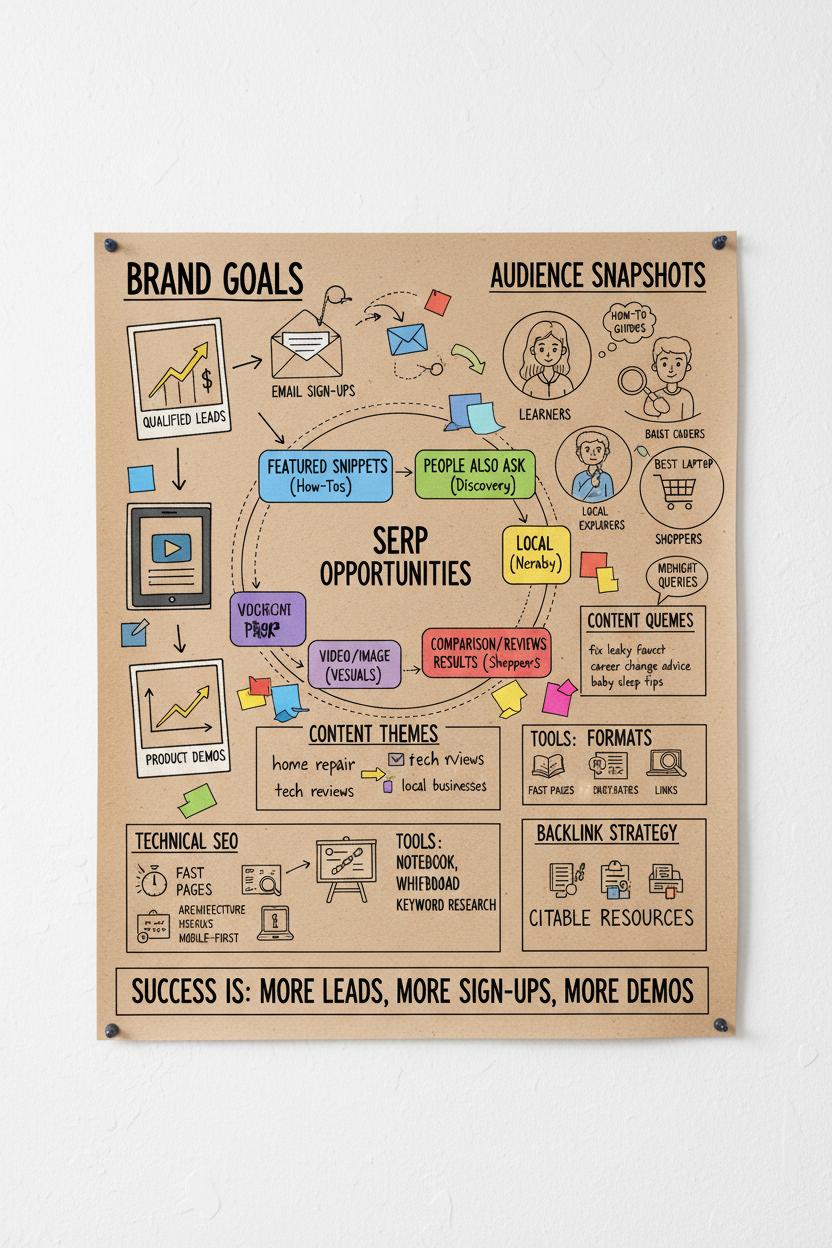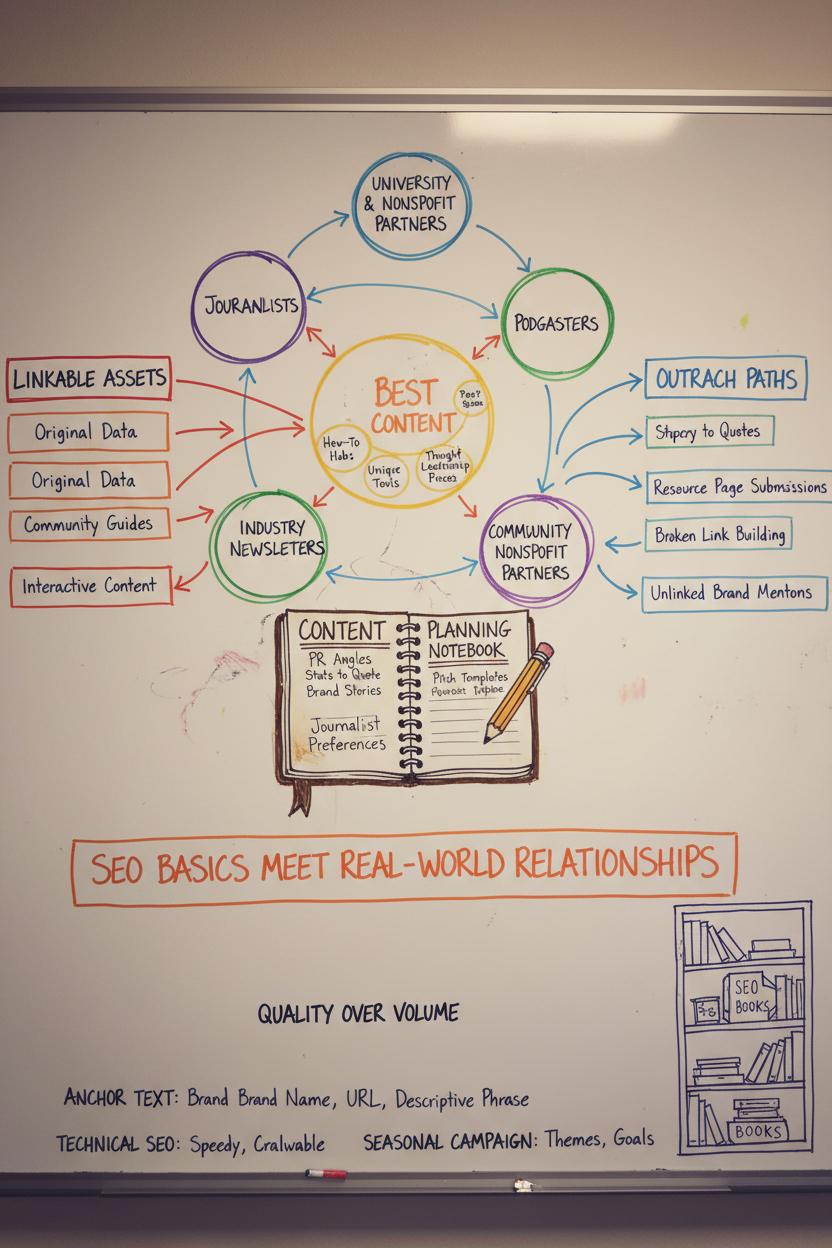Ready to see how search engine optimization actually works? This SEO diagram breaks down SEO basics, technical SEO, content, and backlink strategy into a simple visual map you can follow and pin. Perfect for creators, bloggers, and small businesses who want clarity, not jargon. Grab your content planning notebook and whiteboard for office, open your favorite keyword research tool, and highlight action steps in your marketing planner. Bonus: we’ll share must-read SEO books and templates so you can implement today.
What Is an SEO Diagram? A Visual Guide to Search Engine Optimization

Think of an SEO diagram as a cozy, visual map for search engine optimization—a way to sketch the moving parts of your online presence so they finally make sense together. Instead of keeping a thousand to-dos in your head, you lay out the SEO basics in shapes and arrows: audience intent at the center, a ring of keyword themes around it, and spokes leading to content ideas, internal links, and metrics. It can be a mind map, a flowchart, or a simple layered layout with foundations at the bottom and growth tactics on top. If you’re a visual thinker, it’s like turning your strategy into a mood board: calm, clear, and actionable.
Start with the base layer: technical SEO. Picture boxes for crawlability, page speed, mobile experience, and structured data, all feeding into a clean site architecture. On top of that, cluster your topics—one hub page surrounded by smaller, specific articles—even better if you’ve used a favorite keyword research tool to fill in each cluster with real search terms. Draw arrows for internal links, note which pages answer which intent, and tag your seasonal pieces. Off to the side, map a thoughtful backlink strategy with branches for digital PR, helpful resources, and partnerships. Close the loop with a measurement lane: impressions, clicks, rankings, conversions—then a tidy arrow back to content updates so your diagram breathes and evolves. If you like tactile planning, a whiteboard for office brainstorming is perfect for this; snap a photo when you’re done so the plan travels with you.
Your SEO diagram doesn’t have to be fancy. A content planning notebook can hold quick sketches of clusters and headlines, while a marketing planner keeps timelines, owners, and due dates aligned. Pull ideas from your favorite SEO books, then personalize the map for your brand’s voice and goals. The beauty of seeing it all laid out is the instant clarity: gaps reveal themselves, priorities pop, and your next steps feel grounded. Whether you’re solo or leading a team, this visual guide turns big-picture strategy into an everyday rhythm—one glance, and you know exactly what to create, what to fix, and what to measure next.
SEO Basics to Map First: Goals, Audiences, and SERP Opportunities

Before you dive into tactics, sketch the foundation. I like to start with a simple SEO diagram that feels more like a mood board than a spreadsheet: brand goals on one side, audience snapshots on the other, and a big space in the middle for SERP opportunities. If you’re a pen-and-paper person, a content planning notebook paired with a whiteboard for office brainstorming makes the ideas flow; if you’re digital-first, pull up your favorite keyword research tool. Clarify what success looks like—more qualified leads, more email sign-ups, more product demo requests—and write it boldly in your marketing planner. These anchors keep your search engine optimization efforts aligned when the to-do list gets chaotic.
Now, put your audience under a soft spotlight. Who are they, what are they searching for, and what signals intent? Capture the phrases they use and the problems they whisper to Google at midnight. Map those terms to SERP features that matter: featured snippets for how-tos, People Also Ask for discovery, local pack for nearby intent, video and image results for visual learners, comparison and reviews for shoppers. This is where SEO basics meet editorial instinct—group keywords into themes, then imagine the content formats that would make someone stop scrolling and think, “This is exactly what I needed.”
Finally, set the stage for durability. Technical SEO belongs in the first draft, not the last: fast pages, tidy site architecture, mobile-first layouts, clean internal links. Pair that with a thoughtful backlink strategy focused on creating resources worth citing—original data, handy templates, generous guides. If you want a refresher, keep a few trusted SEO books within reach to sharpen your perspective as you plan. When your goals, audiences, and SERP bets live together on one page, your roadmap stops feeling abstract and starts feeling doable—one page, one post, one improvement at a time.
Powering the Map with Data: Choosing a Keyword Research Tool

Before your SEO diagram can guide anyone anywhere, it needs fuel—and that fuel is search intent wrapped in numbers. This is where choosing a keyword research tool becomes the loveliest kind of nerdy. Look for one that shows search volume, keyword difficulty, and trend lines at a glance, but also peeks into the SERP: what ranks, which features appear, and where you have a realistic shot. Bonus points if it clusters related ideas so you can see topics bloom into content hubs. I like to start with broad phrases tied to search engine optimization and then follow the long-tail tributaries that reveal what real people actually type. Branded versus non‑branded, questions versus comparisons, local flavor versus national scale—your tool should help you slice and sift until the mess becomes a map. As you work, imagine how each cluster will sit inside your visual guide, turning SEO basics into something you can point to and say, “Here’s why this page exists.”
Once you’ve gathered your seeds, sort them like a gardener. Group keywords by intent (learn, compare, buy), match them to page types, and anchor them to your site’s structure so technical SEO isn’t an afterthought. I jot priorities in a content planning notebook, sketch rough flows on a whiteboard for office brainstorms, and then block timelines in a marketing planner so research turns into publish dates, not just pretty ideas. A trustworthy keyword research tool will also surface competitor gaps, which is your cue to plan supporting assets—guides, checklists, and case studies—plus the beginnings of a backlink strategy that feels natural, not forced. If you want deeper context, keep a couple of dog‑eared SEO books nearby; they’re great companions when you’re deciding whether a cluster deserves a pillar page or just a section. In the end, your data doesn’t live in a spreadsheet—it lives in the story your site tells: a clear, confident route through search engine optimization that visitors can follow, and a tidy, color‑coded echo of that route in your SEO diagram that keeps the whole team aligned and inspired.
Backlink Strategy Diagram: Earning Authority with Outreach and PR

Picture your Backlink Strategy Diagram as a cozy constellation you sketch on a whiteboard for office brainstorming: in the center sits your best content, and around it orbit journalists, bloggers, podcasters, industry newsletters, and community sites that your ideal readers already trust. This is where SEO basics meet real-world relationships. In your SEO diagram, draw lines from “linkable assets” like data studies, how-to hubs, and unique tools to outreach paths such as expert quotes, story pitches, and resource page submissions. Keep a content planning notebook nearby to jot PR angles, stats worth quoting, and brand stories with heart. The goal isn’t links for links’ sake—it’s to earn citations that help search engine optimization engines understand your authority while genuinely serving readers.
Start by building irresistible assets, then map the routes that naturally earn mentions: thought-leadership pieces that plug into current trends, original data that reporters love, and community guides others want to reference. Use a keyword research tool to spot questions journalists and creators are already exploring, and weave your answers into something worth bookmarking. Mix classic digital PR with ethical tactics like broken link building, unlinked brand mention reclamation, and outreach to university resource pages or nonprofit partners. Keep anchor text varied and human—brand names, URLs, and descriptive phrases—so your backlink profile looks organic. Quality always wins over volume. And don’t skip technical SEO; a speedy, crawlable page structure helps your earned links actually pass value, while clean design and clear headings make your content easy to cite.
Treat this like a seasonal campaign. In your marketing planner, set themes, story hooks, and weekly outreach goals; then update your SEO diagram as new relationships bloom. Track referring domains, topic clusters that attract the most links, and which pages convert those visits. A shelf of well-thumbed SEO books can spark fresh PR angles, while your content planning notebook keeps pitch templates and journalist preferences tidy. Revisit wins quarterly: repurpose standout assets into press-friendly briefs, pitch a podcast tour, or co-create with a partner brand. When your backlink strategy is visual, warm, and relationship-first, the authority you earn feels inevitable—just like the kind of visibility that compounds month after month.
From Content Planning Notebook to Site Structure: Turning Ideas into Pages

Open your content planning notebook, pour something warm, and imagine every scribbled idea turning into a little home on your website. Start by sketching a simple SEO diagram—nothing fancy, just boxes and arrows on a whiteboard for office brainstorming or a page in your marketing planner. In one column, list your pillar topics; in the next, all the related questions your audience whispers into search bars. Think seasonal angles, evergreen guides, how-tos, and comparisons. This is where SEO basics meet your brand voice: map a user’s path from a broad curiosity to a confident decision. If you need inspiration, flip through a couple of favorite SEO books, then refine your clusters with a trusted keyword research tool so each page idea has a clear intent and a primary phrase to anchor it.
Next, translate that sketch into site structure. Pillars become top-level categories, clusters become subpages, and each page gets a job: educate, compare, or convert. Build logical menus, add breadcrumbs, and keep URL slugs tidy and descriptive so both people and crawlers feel oriented. Technical SEO slips in like good lighting—quiet but transformative—through fast load times, mobile-friendly layouts, compressed images, and clean internal linking that surfaces related posts. As you draft, note the schema you might add (articles, FAQs, products) and how media will support the story. Your SEO diagram becomes a living blueprint: from homepage to categories to posts, every click should feel like a gentle nudge forward.
Finally, give your pages a social life with a thoughtful backlink strategy. Create linkable assets—original research, data visualizations, checklists—and plan outreach to partners and publications that serve your audience. Keep everything on track inside your marketing planner: publish pillars first, then layer cluster posts, and circle back to interlink new pieces. Each draft gets human-friendly headings, skimmable sections, and meta details that mirror search intent. When your notes evolve into a navigable structure, search engine optimization no longer feels abstract; it feels like hospitality—inviting, well-signposted, and perfectly tailored to the questions your readers bring to your door.
Whiteboard for Office Workshops: Collaborative SEO Diagram Sessions

Imagine gathering your team around a bright, squeaky-clean whiteboard for office workshops, music low, coffee warm, and a rainbow of markers at the ready. This is where an SEO diagram really comes to life—big, visual, collaborative, a map that makes search engine optimization feel less abstract and more like a creative studio session. Start by sketching the SEO basics in broad strokes: audience intent at the center, keyword clusters in soft circles, and content pillars branching off like friendly vines. Pull insights from a keyword research tool and jot the strongest phrases along the edges, then highlight the questions your ideal readers are actually asking. Keep a couple of your favorite SEO books on the table for quick “Is that still best practice?” flips, because little checks like that keep the conversation practical and grounded.
Once the fundamentals are down, layer in the nerdy-good stuff: technical SEO. Draw a clean site architecture as a ladder, with internal links tying steps together. Add icons for Core Web Vitals, mobile friendliness, page speed, and structured data—tiny stars that signal “don’t forget me.” If you’re revising an older site, use different marker colors to show what’s live versus what’s planned, and note who owns each fix. That’s the magic of a collaborative SEO diagram—everyone can see the sequence of tasks, the dependencies, and the simple wins that make everything run smoother.
Finally, sketch your backlink strategy like a constellation, connecting target publications, partnerships, and content assets with dotted lines to outreach steps. Capture your best ideas before they fade by snapping photos and transferring next actions into a content planning notebook and your marketing planner. Assign deadlines, tag owners, and translate the drawing into a sequence of sprints. The session ends with a tidy board and a clear roadmap—plus a shared sense of momentum that’s hard to get from a spreadsheet alone. When you make space for collaboration and keep your tools simple—a trusty whiteboard for office brainstorming, a reliable keyword research tool, a couple of dog-eared SEO books, and a planner you love—search engine optimization stops feeling like a maze and starts feeling like a creative craft you can actually master together.
Measurement Layer: KPIs, Dashboards, and Iteration Loops

In the measurement layer of our SEO diagram, think of KPIs and dashboards as the soft glow of string lights guiding your steps—pretty to look at, but also practical when you’re moving furniture. Measurement turns search engine optimization from guesswork into a cozy, repeatable ritual. Start by pairing your goals with a handful of crisp KPIs: impressions and clicks for visibility, click-through rate and average position for momentum, and conversions or assisted revenue for real-world impact. Keep it simple at first—SEO basics like tracking top queries and best-performing pages—then graduate into richer views like branded vs. nonbranded traffic, share of voice for key topics, and page groups by intent. I love using a keyword research tool to cluster terms and a content planning notebook to capture insights you can test later.
Dashboards should feel like a living mood board for your site. Pull Search Console for queries and pages, Analytics for engagement and conversions, and your rank tracker for position trends. Add annotations for every publish date, template tweak, or internal link update so the story is obvious at a glance. A whiteboard for office brainstorming helps translate those squiggly lines into next steps, while a marketing planner can schedule your check-ins: quick weekly scans for anomalies, deeper monthly reviews for patterns, and quarterly retros to prune what’s not working.
Technical SEO deserves its own lane in the dashboard. Track Core Web Vitals, crawl errors, index coverage, 404s, and server response times. If a layout shift drops after a template fix, note it; when speed improves, watch for rising CTR and conversion. Your backlink strategy gets similar treatment: monitor new referring domains, link velocity, topical relevance, and the authority of linking pages—then connect those dots to rankings and nonbranded traffic for the linked URLs. The iteration loop is simple and soothing: hypothesize, ship, measure, reflect, repeat. Borrow frameworks from your favorite SEO books, sketch ideas in the margins, and keep your tests small but steady. Measurement isn’t a finish line; it’s the heartbeat of search. When your KPIs, dashboards, and loops hum together, the rest of your SEO diagram comes into focus—clear, actionable, and a little bit beautiful.
Learning Path: SEO Books That Complement Your Diagramming

When you’re building out your SEO diagram and pinning it above your desk like a mood board for your website, a few well-chosen SEO books can become your quiet mentors in the corner. Start with titles that walk through SEO basics in plain language—think chapters that trace the user journey from query to click, then onward to conversion. As you read, translate each insight into shapes and arrows on your whiteboard for office, mapping how search engine optimization moves from keyword intent to crawlability, then to content quality and, finally, to measurement. I like to keep a keyword research tool open while I read, feeding real phrases into the nodes of my diagram so the theory gets anchored to actual search behavior. If you’re a paper person, a content planning notebook paired with a marketing planner creates an analog home for your ideas, deadlines, and experiments, so the diagram never floats untethered from your publishing calendar.
As your understanding matures, lean into books that dig into technical SEO without losing you in the weeds. The best ones unpack site architecture, internal linking, structured data, and page speed with examples you can sketch—sitemaps as tree branches, canonical tags as tidy labels, redirects as signposts between paths. Each technical concept becomes a block on your SEO diagram, and suddenly you can see bottlenecks and quick wins with fresh clarity. Then layer in reading on backlink strategy, not just the “how” but the “why”—relevance, authority, and relationship-building that fits your brand. I like to draw link neighborhoods like cozy cul-de-sacs, marking which partnerships make sense and which detours to avoid. Keep your notes close and your edits fluid; a whiteboard for office lets you reshuffle priorities in seconds, and a marketing planner keeps launches, audits, and outreach in a cadence you can actually sustain.
Finally, round out your library with SEO books that cover analytics storytelling—turning dashboards into decisions. Let those chapters guide the legend for your diagram: which metrics light up each section, where to add a feedback loop, when to prune. With a cup of coffee, soft music, and your content planning notebook open, you’ll find that reading and drawing work together: the books give you depth, the diagram gives you direction, and your search engine optimization strategy becomes something you can see, touch, and steadily improve.
Common Pitfalls and Fixes: Keeping Search Engine Optimization Clear

If your search engine optimization feels like a messy junk drawer, you’re not alone. The quickest fix is to slow down and sketch your process, pinning each step to a simple SEO diagram so you can see what’s working and what’s just clutter. Start with SEO basics: match search intent before you chase volume, write for a real person before you polish for bots, and give each page a single, memorable purpose. I like to sit with a content planning notebook and a marketing planner open side by side, then run a quick check in a favorite keyword research tool to confirm that my headline, subheads, and meta description align with what people actually type. When everything is laid out visually, you’ll feel the fog lift.
Technical SEO trips up even seasoned pros because it hides behind the scenes. Slow image-heavy pages, clunky JavaScript, duplicate titles, and sneaky redirect chains can quietly siphon away traffic. Schedule a monthly sweep: test Core Web Vitals, fix broken links, compress images, and keep your internal links tidy. A whiteboard for office brainstorming is perfect for sketching site architecture—home, hubs, and spokes—so you can spot orphan pages and plan clean navigation. Don’t forget the quiet helpers: descriptive alt text, canonical tags for similar pages, and basic schema to give search engines an extra hint. When your technical SEO is neat, the rest of your efforts show up brighter.
Backlinks are powerful, but a rushed backlink strategy can backfire. Chasing spammy directories, mass guest posts, or over-optimized anchors usually leads to volatility. Instead, think “worthy of a save.” Create linkable assets—checklists, data roundups, templates—and offer helpful quotes or mini case studies to niche publications. Keep an organized outreach list in that same content planning notebook, note anchor text variety in your marketing planner, and audit your profile quarterly. A couple of well-thumbed SEO books can sharpen your instincts on what to pursue and what to ignore. Finally, return to your SEO diagram, pin your best wins, and remove anything that doesn’t serve the goal. Clarity is a strategy, and it makes search engine optimization feel less like guesswork and more like a beautiful, repeatable routine.
Conclusion
Now you can see the whole journey at a glance: our SEO diagram turns search engine optimization into a simple, visual rhythm. Start with SEO basics, tighten your technical SEO, and nurture a smart backlink strategy—each layer supporting the next. Save this guide, pin the graphic, and come back whenever you need a gentle nudge. Brew a warm cup, review your steps, and make small, steady tweaks. With clarity and consistency, your pages can bloom. You’ve got this—one thoughtful click, one tidy fix, one bright result at a time.